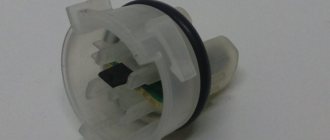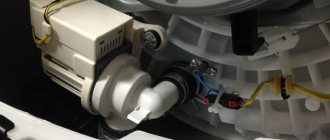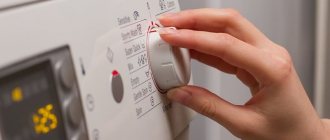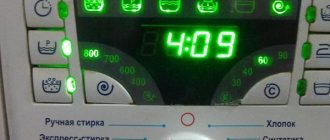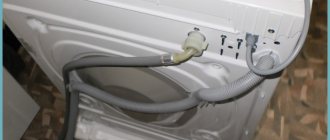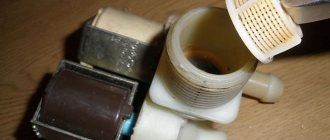The washing machine does not heat the water when washing. This problem occurs quite often, and there are many reasons why the water does not heat up. It is very important to eliminate this problem, because washing different types of laundry requires a certain temperature.
Every housewife knows that in order to achieve the best washing result, you should select the desired temperature mode. For this purpose, there is a special tag on things, which indicates a point or digital value of the recommended temperature. If woolen items are washed in cold water, then bed linen or towels are washed in water heated to a certain temperature. But what to do if the washing machine does not heat the water? This article will describe and analyze the main causes of this malfunction, as well as ways to solve them.
How to check if a washing machine is heating water
A situation may occur when the washing unit has fully completed all stages of washing, but the laundry was poorly washed, although the same detergent was used. One of the reasons may be non-compliance with the temperature regime. In other words, the machine washed clothes in cold water. In this case, it is worth checking whether the water entering the washing drum is heating up.
To do this, you need to select one of the washing modes, which involves heating the water to a temperature of 50-60*C and 20 - 30 minutes after it starts, touch the glass of the loading hatch. For top-loading machines, place your palm on the top cover. If these elements are warm, the water heats up; if they are cold, the washing unit is faulty. After finishing washing, you should identify the causes of the malfunction and eliminate the malfunction. Further use of the washing machine will not only not lead to the desired washing result, but may also render it completely unusable.
Call the master: where to find, how to avoid falling for scammers?
If independent repairs do not lead to a positive result and the Samsung washing machine still does not start heating water, then professionals will come to the rescue.
There are several ways to select and call a technician . The first and easiest is to look for information on the Internet. There are a sufficient number of service center websites, as well as private advertisements on forums, after studying which you can choose the right specialist.
If for some reason there is no access to the Internet, you can call a repairman to your home using an advertisement in the newspaper or by finding out the coordinates from friends.
In order for the washing machine repair to be completed successfully, when calling a technician to your home, you should pay attention to the following points:
- a professional will listen carefully, ask questions about the brand of the washing machine, the type of breakdown, the year of manufacture of the household appliance (fraudsters are not interested in this information);
- an honest master will never take an advance payment without even assessing the volume of work;
- A decent specialist is always in touch and answers all questions.
If the repair is carried out by a service center specialist, upon completion of the work he must draw up a corresponding report (in two copies), which is signed by both parties.
Replacing a heating element will cost an average of 1,000 rubles, replacing a thermostat - from 1,300 rubles. Only a specialist can announce the exact cost of the work after a complete diagnosis of the breakdown.
The final amount may be affected by:
- complexity and urgency of the work,
- cost of new spare parts (prices vary depending on the model and manufacturer).
Everything about repairing Samsung washing machines is in this section of the site.
Reasons why the washing machine does not heat the water
A washing unit is a complex household device consisting of many elements. The reason for the lack of water heating may be a malfunction or breakdown of:
- heating element (heating element);
- water heating sensor (thermostat);
- programmer (electronic unit);
- water level sensor in the tank (pressostat).
Also, the water may not heat up enough when:
- incorrect connection of the washing unit to the drainage system, resulting in self-draining of heated water caused by the siphon effect;
- incorrect choice of washing program, in which the selected mode in favor of a higher temperature mode is ignored.
There are many reasons why the machine does not heat the water, so in order to find out the source of the malfunction, you need to follow the principle “from simple to complex.”
Causes of malfunction
A washing machine is a complex mechanism that includes a huge number of elements.
If the washing machine does not heat the water, then a malfunction is possible for one of the following reasons:
- the electric water heater broke down;
- The thermostat has deteriorated;
- the electronic control unit has deteriorated;
- It is necessary to install a new water level sensor.
Partial heating occurs due to:
- incorrect connection of the washing machine to the drain system;
- The wrong washing program has been selected.
Wash temperature setting is incorrect
Before moving on to radical measures to disassemble the washing machine, it would not hurt to check the banal reason for washing in cold water. Take the instructions and study them carefully. Some modes, for example, “Delicate wash” or “Silk items”, by definition, do not use heating water.
If the specified program uses heating, check that the settings are correct. Temperature readings may simply not correspond to the program, which is why the water will remain cold. This is especially true for the newest models of washing machines, which, as a rule, are equipped with two separate program setting controls.
The heating element has failed
A water heating element fails, usually due to a voltage surge in the electrical network, a manufacturing defect, a short circuit or natural destruction of the element due to the aging of household appliances. A burnt heating element must be replaced.
Scale on the heating element
The heating element may be working properly, but heat the water to lower temperatures than set by the selected program. This happens due to hard water, which contains large amounts of calcium and magnesium salts. Salts contribute to the formation of scale on the walls of the heating element, as a result of which the heat transfer of the heating element deteriorates. In addition, the heating element begins to overheat and sooner or later will fail.
To get rid of a layer of scale, use one of the cleaning products for water heating elements. The easiest way is to take 100 grams of powdered citric acid, pour it into an empty laundry drum and turn on the wash for an hour and a half at a water temperature of 60 degrees. This time is enough to completely corrode the accumulated scale on the heating element.
Control unit failure
Sometimes the electronic control unit fails. The reason for this may be a software failure or breakdown of any electrical components.
Electrical components may fail due to short-term voltage surges. The control board may be damaged due to frequent vibration loads during the washing process. For these reasons, the normal operation of the module is disrupted, after which the signal to turn on the heating element stops.
Thermal sensor has failed
Temperature sensor location
The temperature sensor (thermostat) is designed to control the temperature inside the tank. Since any washing program has a specific temperature, the electronic control unit constantly compares the thermostat data with the programmed data from the ROM.
If the thermostat breaks down, the washing machine may either not heat the water or bring it to a boil. In the vast majority of washing machines, this sensor is located near the heating element or on the heater panel. Using a multimeter you can check whether it is working or not.
Replacing the temperature sensor with a new one occurs as follows:
- remove the rear cover of the unit;
- disconnect the connector with wires from the thermostat;
- remove the faulty sensor from the socket and install a working one in its place;
- reconnect the connector with wires.
Damage to the water level sensor
In some cases, the pressure switch becomes unusable. This device is necessary to control the water level in the tank. Using a tube connected to the sensor membrane, the pressure switch measures the pressure created by the water. Sometimes the tube becomes clogged with all sorts of small debris, animal hair, or pieces of fabric.
The owner of the device will need to clean the tube by removing the top cover. A pressure sensor will be installed on the right or left side of the housing. Simply remove the clamp and disconnect the tube for cleaning. If this does not correct the situation, then the pressure switch will need to be replaced.
The wiring to the heating element is faulty
Due to increased vibrations during spinning, sometimes a break occurs in one of the conductive circuits. The frayed wires are soldered and carefully insulated. If you have not found the location of the wiring break, you will need to contact a washing machine repair technician.
Self-draining of hot water due to improper connection of the washing machine to the sewer
If you connect the washing machine to the drain hole incorrectly, the water will flow down the drain spontaneously. It will not warm up to the required temperature due to constant draining and auto-topping.
Identifying the faulty element
If periodic self-draining of warm or hot water occurs (can be monitored by heating the drain hose), it is necessary to eliminate the siphon effect and correctly connect the washing unit to the drain system. The problem is successfully solved by installing a check valve in the system.
If the washing machine does not heat the water at all, you should remove the back or side covers and check the connection of the heating element terminals (TENA) with the current-carrying wires.
When washing, especially in spin modes, all elements of the washing unit are subject to vibration loads, which can lead to separation of the elements. By reconnecting the disconnected wire, you can eliminate the problem.
Washing units from Samsung, LG, Ariston, Candy, Bosch and other well-known brands have a similar structure and connection of heating elements. As a rule, a tubular heating element is used, which converts electrical energy into thermal energy by creating electrical resistance.
Adviсe
- If your washing machine has been in use for more than 7 years, most likely most of the problems in its operation are related to the heating element. The quality of our tap water leaves much to be desired, so the service life of the heating element is noticeably reduced. Experts advise replacing this element as soon as the first problems appear.
- Modern models of washing machines are equipped with a forced water heating function (read how to start it in your user manual). If the thermostat malfunctions, this function will help you do without replacing the water temperature sensor for some time.
- One of the indicators that the washing machine is not heating the water is the musty smell of the washed items. It does not always appear, but if you notice it, first of all you need to test the heating element for serviceability.
- In order to extend the service life of the tubular heating element (after all, interruptions in water heating are most often associated with it), you need to use only high-quality washing powders and not exceed the dosage of detergents and care products. If you are concerned about the quality of your tap water, install a flow-through filter to reduce the hardness level.
Sources
https://vannayasovety.ru/tekhnika/stiralnaya-mashina-ne-greet-vodu.html https://o-vannoy.ru/stiralnaya-mashina/ne-greet-vodu/
Diagnostics of heating element
Failure of the heating element is the most common reason that the water in the washing machine does not heat up. Under normal conditions, the heating element is designed for a long period of operation, 5 - five or more years. However, hard water, low-quality detergents or failure to comply with the operating conditions of the washing unit lead to the formation of scale on the heating element. As a result of this, the heat transfer process is disrupted, the heating element overheats and burns out.
Electric heating elements are used in many household appliances: kettles, pressure cookers, boilers, etc. They can be dry or wet type. Dry heating elements do not come into direct contact with water or other liquid. Washing units from most manufacturers use wet heating elements. Korean washing machines Samsung and LG, Italian Ariston or German Bosch are all equipped with similar heating elements. They may vary in appearance and power.
Household washing units use heating elements with a power of 1.5 to 2.5 kW. The power is usually indicated on the device case, or in the accompanying technical documentation. In order to make sure that the heating element is working, you need a multimeter (tester). To ensure an accurate check, it is better to calculate the resistance for a specific element using the formula:
R=U²/P where:
R – resistance in Ohm;
U – network voltage in V;
P – heating element power W.
For example, let's take a heating element with a power of 2000W (or 2 kW).
R= 220²/2000= 24.2 Ohm
The calculated resistance for a 2 kW heating element was 24.2 Ohms.
To check you need:
- disconnect the wires from the heating element connectors;
- switch the multimeter to resistance measurement mode with a measurement range of no more than 1000 Ohms;
- Touch the probes of the multimeter to the outer terminals (contacts) of the heating element.
If the heating element is working properly, the device readings should be close to the calculated value. “Zero” indicates a short circuit inside the heating element and it needs to be replaced. If the device readings show “one” or the “infinity” symbol, the heating element has a break, and it also requires replacement.
To check the breakdown on the body, the tester switch is set to the “buzzer” mode and one of the probes of the device is connected to one of the contacts of the tank, the other to the body of the heating element. If there is no breakdown in the housing, the multimeter's buzzer will not sound. Otherwise, if the device beeps or displays numbers, then there is a breakdown in the housing, and the heating element requires replacement.
Question answer
Why does water take so long to heat up?
Any part does not break immediately, it does so gradually. Most likely, your heating element is broken - a large amount of scale has formed on it. To descale the heating element, add water softener during washing.
How to determine that there is no heating?
To understand whether the machine heats the water, start the wash at a temperature of 40 degrees. After half an hour, place your palm on the glass of the hatch. If it's cold, there really is a problem.
Temperature sensor diagnostics
If the heating element is working properly, but the water in the washing machine does not heat up, we check the water heating sensor in the washing tank.
As a rule, it is located on the body of the heating element and is a small metal cylinder with connected electrical wires, however, on some units, for example Bosch, its appearance may be different. To do this you will need:
- disconnect the sensor wires and carefully remove it from the tank;
- use a multimeter to measure its resistance and remember the readings of the device;
- place the sensor in hot water and measure the resistance again; if the difference in readings is significant, the sensor is working; if not, it needs to be replaced.
Debugg
A number of problems with the washing machine can be resolved on your own without involving a technician from the service center. To determine the cause of the failure, you will need to conduct diagnostics.
Self-diagnosis can be carried out for the following elements of the unit:
- Water level sensor (cleaning of small debris).
- Water heater (removal of scale and rust).
- Wiring.
Some components of the washing machine can be checked using a multimeter, if necessary, replacing failed elements with new ones. An exception may be a programmer or control unit, the repair of which will need to be entrusted to a specialist.
If you do not find any faults with the above components of the washing machine, check that the device is connected to the drain correctly.
For this:
- Unplug the washing machine.
- Check all hoses.
- Clean the filters.
- Install the ball valve.
- The drain hose should be located at a height of 50-100 cm from the floor.
It is best to drain through a sink or bathtub siphon.
Checking the pressure switch
If the heating element and temperature sensor are working properly, and the washing machine does not heat the water, you need to check the water level sensor in the tank (pressostat).
If the pressure switch tube is clogged with lint and small debris, it may result in the sensor not sending a signal that the washing tank is full of water. As a result, the control module does not turn on the heating element, or does not give a signal to open the intake valve. As a result, the water does not heat up in the washing machine. You can determine the blockage visually by removing the top or side cover of the washing unit and removing the tube.
Replacing the heating element
What to do when you finally get to the heating element? You need to check the element using a multimeter. The first probe of the device is carefully installed on one contact of the heater, the second is attached to the second contact. Afterwards, you need to monitor the meter readings displayed on the screen. When the resistance value is within 25-30 Ohms, it means that the heater is working and is functioning normally; if the multimeter display shows the number 0 or 1, therefore, the heating element is not working.
Having purchased a new similar heater, it is necessary to replace the part. To do this you will need a socket wrench. Take the tool and unscrew the nut located between the two contacts of the heating element. This will remove the main fastener that holds the heater in place. But in addition to the nut, the device also has a spacer, so the action plan will be as follows:
- remove the nut;
- grab the contacts of the heater with your hands and carefully swing it in different directions;
- using a small hammer, lightly tap the stud with which the nut was screwed, the stud should fall slightly into the body;
- pry up the heating element using a flat screwdriver, so you can slightly move the heater from its place;
- hold the contacts and pull the element out.
Important! You must pull out the heater by the contacts with extreme caution, and the point is not that it is a pity to damage the non-working part, but that if they accidentally break off, getting the non-working part out of the housing will be quite problematic.
Having pulled out a burnt heating element from the washing machine, you will probably see that the part is covered with a layer of plaque and scale, and you may notice the presence of black spots on it. Take your new heater and test it using a multimeter. After making sure that the element is working properly, you can begin installation. To do this, you need to lubricate the rubber element of the heating element with a drop of machine oil and place the part in the tank. Then the temperature sensor is installed in place, all wiring is connected to the contacts, the SMA is assembled in the reverse order and tested for functionality.
Interesting:
- Rating of Samsung washing machines
- Reviews of Samsung washing machines
- Review of a Samsung washing machine with an additional door
- Review of Samsung washing machines with inverter motor
- Washing synthetics in a washing machine
- Samsung washing machines
Reader comments
- Share your opinion - leave a comment
Checking the electronic module
Malfunctions in the operation of the programmer or control unit can be caused by both software failures and failure of the electrical part.
A voltage drop can lead to burnout of electrical components. Vibration loads cause mechanical damage to electrical circuit boards. All these reasons lead to programmer failures, and the signal to turn on the heating element is not given. At home, it will be difficult to identify the cause of the malfunction, and it is better to entrust the elimination of defects in the control unit to the service center technicians.
Attention! When carrying out all work on diagnosing and repairing the internal elements of the washing unit, it is necessary to disconnect it from the electrical circuit.
